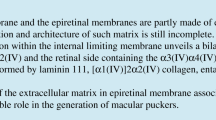Abstract
• Background: Posterior perforating eye injury carries a high risk of visual loss due to the formation of intravireal and epiretinal scar tissue. Intraocular scar formation in patients with retinal detachment has been shown to be associated with elevated intravitreal FN levels. The extracellular matrix glycoproteins fibronectiu (FN) and tenascin (TN) have been located in epiretinal scar membranes. As both FN and TN are also involved in healing of cutaneous and corneal wounds, we undertook to study their expression in rabbit perforating scleral wounds with vitreous incarceration. • Methods: A perforating scleral wound was produced and sutured without removal of vitreous from the wound in 18 pigmented rabbits. The rabbits were killed at various times (1 h to 21 days) after the operation, and the indirect immunohistochemical method was used for demonstration of FN and TN. Monoclonal mouse hybridoma antibodies 52 DH1 and 100 EB2, recognizing the cellular form of FN (cFN) and TN, respectively, were used. • Results: During the first post-operative week immunoreaction for glycoproteins, both the locally produced cFN and TN, were observed at the scar tissue containing the prolabed vitreous and the adjacent sclera. Subsequently, the reaction gradually shifted to the vitreal side of the wound, and 3 weeks after the operation it was almost completely restricted to a separated mass of vitreous beneath the scar. • Conclusion: The expression of cFN and TN in the scleral scar and vitreous is indicative of their local synthesis. The shift of the expression of those proteins to the vitreal side of the wound with time suggests that the scarring process in the vitreous is delayed compared to the sclera.
Similar content being viewed by others
References
Campochiaro PA, Jerdan J, Glaser BM (1984) Serum contains chemo-attractants for human retinal pigment epithelial cells. Arch Ophthalmol 102:1830–1833
Chiquet-Ehrismann R, Mackie EJ, Pearson C, Sakakura T (1986) Tenascin: an extracellular matrix protein involved in tissue interactions during fetal development and oncogenesis. Cell 47:131–139
Chiquet-Ehrismann R, Kalla P, Pearson C, Beck K, Chiquet M (1988) Tenascin interferes with fibronectin action. Cell 53:383–390
Cleary PE, Ryan SJ (1978) Posterior, perforating injury. Experimental animal model. Trans Ophthalmol Soc UK 98:34–37
Daicker B (1985) Constricting retroretinal membranes associated with traumatic retinal detachments. Graefe's Arch Clin Exp Ophthalmol 222:147–153
Erickson H, Lightner VA (1988) Hexabrachion protein (tenascin, cytotactin, brachionectin) in connective tissues, embryonic brain, and tumours. Adv Cell Biol 2:55–90
Erickson H, Bourdon M (1989) Tenascin: an extracellular matrix protein present in specialized embryonic tissues and tumours. Annu Rev Cell Biol 5:71–92
Hiscott P, Waller HA, Grierson I, Butler MG, Scott DL, Gregor Z, Morino I (1992) Fibronectin synthesis in subretinal membranes of proliferative vitreoretinopathy. Br J Ophthalmol 76:486–490
Howeedy AA, Virtanen I, Laitinen L, Gould NS, Koukolis GL, Gould VE (1990) Differential distribution of tenascin in the normal, hyperplastic, and neoplastic breast. Lab Invest 63:798–806
Immonen I, Salonen E-M, Laatikainen L, Vaheri A (1989) Fibronectin in subretinal fluid. In: Heimann K, Wiedemann P (eds) Proliferative vitreoretinopathy. Kaden, Heidelberg, pp 109–112
Immonen I, Tervo K, Virtanen I, Laatikainen L, Tervo T (1991) Immunohistochemical demonstration of cellular fibronectin and tenascin in human epiretinal membranes. Acta Ophthalmol (Copenh) 69:446–471
Jones FS, Burgoon MP, Hoffman S, Crossin KL, Cunningham BA, Edelman GM (1988) A cDNA clone for cytotactin contains sequences similar to epidermal growth factor-like repeats and segments of fibronectin and fibrinogen. Proc Natl Acad Sci USA 85:2186–2190
Lotz MM, Burdsal CA, Erickson HP, McClay DR (1989) Cell adhesion to fibronectin and tenascin: quantitative measurement of initial binding and subsequent strengthening response. J Cell Biol 109:1795–1805
Mackie EJ, Halfter W, Liverani D (1988) Induction of tenascin in healing wounds. J Cell Biol 107:2757–2767
Mensing H, Pontz BF, Müller PK, Gauss-Miiller V (1983) A study on fibroblast chemotaxis using fibronectin and conditioned medium as chemo attractants. Eur J Cell Biol 29:268–273
Newsome DA, Pfeffer BA, Hewitt AT, Robey PG, Hassel JR (1988) Detection of extracellular matrix molecules synthesized in vitro by monkey and human retinal epithelium: influence of donor age and multiple passages. Exp Eye Res 46:305–331
Shrakawa H, Yoshimura N, Yamakawa R, Matasumura M, Okada M, Ogina N (1987) Cell components in proliferative vitreoretinopathy: immunofluorescent double staining of cultured cells from proliferative tissue. Ophthalmologica 194:56–62
Tervo K, Tervo T, van Setten G-B, Tarkkanen A, Virtanen I (1989) Demonstration of tenascin-like immunoreactivity in rabbit corneal wounds. Acta Ophthalmol (Copenh) 67:347–350
Tervo K, van Setten G-B, Beuerman RW, Virtanen I, Tarkkanen A, Tervo T (1991) Expression of tenascin and cellular fibronectin in rabbit cornea after anterior keratectomy: immunohistochemical study on wound healing dynamics. Invest Ophthalmol Vis Sci 32:2912–2918
Topping TM, Abrams GW, Machemer R (1979) Experimental double-perforating injury of the posterior segment in rabbit eyes: the natural history of intraocular proliferation. Arch Ophthalmol 97:735–742
Vaheri A, Salonen E-M, Vartio T (1985) Fibronectin in formation and degradation of the pericellular matrix. In: Evered D, Whela J (eds) Fibrosis, Ciba Foundation Symposium 44. Pitman, London, pp 111–126
Vartio T, Laitinen L, Narvanen O, Cutolo M, Thornell LE, Zardi L, Virtanen I (1987) Differential expression of the ED sequence-containing form of cellular fibronectin in embryonic and adult human tissues. J Cell Sci 88:419–430
Weller M, Wiedemann P, Heimann K, Zilles K (1988) The significance of fibronectin in vitreoretinal pathology. A critical evaluation. Graefe's Arch Clin Exp Ophthalmol 226:294–298
Yeo JH, Sadeghi J, Campochiaro PA, Green WR, Glaser B (1988) Intravitreous fibronectin and platelet-derived growth factor. New model for traction retinal detachment. Arch Ophthalmol 104:417–421
Author information
Authors and Affiliations
Rights and permissions
About this article
Cite this article
Tervo, K., Latvala, T., Suomalainen, VP. et al. Cellular fibronectin and tenascin in experimental perforating scleral wounds with incarceration of the vitreous. Graefe's Arch Clin Exp Ophthalmol 233, 168–172 (1995). https://doi.org/10.1007/BF00166610
Received:
Revised:
Accepted:
Issue Date:
DOI: https://doi.org/10.1007/BF00166610




